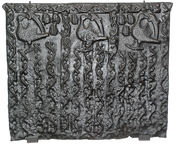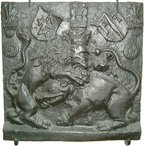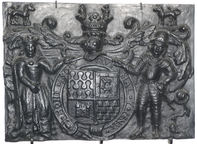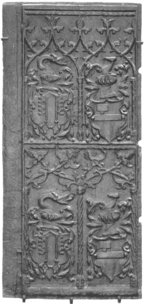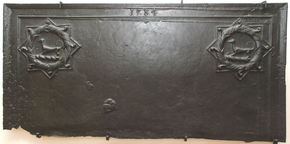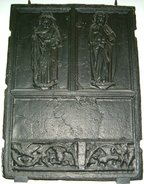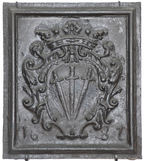-
735
Description: Rectangular; three birds (probably swans, a Lancastrian badge) turned to the left, their heads facing right, and the front edge of their left wing extended and inverted; vine pattern strips, one horizontal along the top, and 14, of varied length, vertically across the rest of the fireback; seven ‘grape bunch’ shapes with criss-cross markings, arranged in three groups — 3-1-3 — adjacent to the birds.
Notes: The same vine strips are found on several firebacks, including some of the ‘Anne Forster’ series; the birds are also seen on a number of firebacks; the ‘grape bunch’ shapes may be the same as those on the ‘Anne Forster’ graveslab in Crowhurst church, Surrey. John Starkie Gardner and later writers attributed the birds to an association with the Fowle family; this is unlikely to be correct as the Fowles came to prominence in the iron industry towards the end of the sixteenth century and had their own distinctive decorative emblems. Formerly in the collection of Lady Dorothy Nevill.
- Decoration tags:
- rectangular (shape)
- complex, furniture-derived (edging)
- simple stamps
- carved stamps
- animals
- objects
Manufactured: in the mid- to late-16th century possibly at Pounsley Furnace, Framfield in the Weald area of England.
Current location: Victoria & Albert Museum, Cromwell Road, Kensington & Chelsea, Greater London, England.
Museum number: M.120-1914 (part of the Victoria & Albert Museum museum group)
Citation: Dawson, C., 1903, 'Sussex Iron Work and Pottery', Sussex Archaeological Collections, 46, pp. 1-54.
Citation: Gardner, J. S., 1898, 'Iron Casting in the Weald', Archaeologia, 56, 1, pp. 133-164.
Citation: Straker, E., 1931, Wealden Iron (London, Bell).
- Attached to series:
- Pounsley series
- Vine strip series
- Swan series
- Furniture stamp firebacks
-
739
Description: Rectangular; a crowned lion fighting a boar in high relief on a raised bottom panel; above, a stamp formed from a fleur-de-lys on a bracket repeated three times, centre left and right corners; two angled shields and two sunburst discs.
Notes: The shields probably signify civic or personal allegiance; the symbolism of the fighting beasts is not known. Part of the bequest to the Victoria and Albert Museum by Lieut. Colonel G. B. Croft-Lyons in 1926.
Inscription: P T
- Decoration tags:
- rectangular (shape)
- none (edging)
- whole carved pattern
- heraldic
- armorial
- text
- animals
Manufactured: in the late-16th to early-17th century in Germany.
Current location: Victoria & Albert Museum, Cromwell Road, Kensington & Chelsea, Greater London, England.
Museum number: M.576-1926 (part of the Victoria & Albert Museum museum group)
- Attached to series:
- Foreign armorial firebacks
-
740
Description: Plain rectangular plate; shield, garter, helm, mantling and supporters of the Blount family, Lords Mountjoy.
Notes: The arms are those of Charles Blount, 8th Baron Mountjoy, who was invested Knight of the Garter in 1597. He was created 1st Earl of Devonshire in 1603. Blazon: 1. (Blount) Barry nebuly of six Or and Sable; 2. (Ayala) Argent, two wolves passant Sable on a bordure of the first eight saltires Gules; 3. (Mountjoy) Or a tower Azure; 4. (Gresley) Vair. An unusually bold and detailed casting; the buckle missing from the garter suggests that this plate has been cropped from a larger fireback.
Inscription: HONI·SOIT·QVI·MAL·Y·PENSE
Arms: Charles Blount, KG, 8th Baron Mountjoy
- Decoration tags:
- rectangular (shape)
- none (edging)
- whole carved pattern
- armorial
- text
Manufactured: in the late-16th to early-17th century in England.
Current location: Victoria & Albert Museum, Cromwell Road, Kensington & Chelsea, Greater London, England.
Museum number: 323.1907 (part of the Victoria & Albert Museum museum group)
- Attached to series:
- Personal armorial firebacks
- Mountjoy series
-
745
Description: Rectangular; flanged edging; two panels, each with fillet edging; upper panel, two shields, each with helm and crest, between narrow twisted columns, with tracery above and a twisted horizontal pole on top; lower panel, same shields and twisted columns with a crossed vine design above and the same pole on top.
Notes: Probably arms of locksmiths' and masons' guilds.
- Decoration tags:
- rectangular (shape)
- flanged (edging)
- whole carved pattern
- architectural
- armorial
Manufactured: in the mid- to late-16th century in Germany.
Current location: Victoria & Albert Museum, Cromwell Road, Kensington & Chelsea, Greater London, England.
Museum number: M.12-1940 (part of the Victoria & Albert Museum museum group)
- Attached to series:
- Stoveplates
-
751
Description: Rectangular, cavetto moulded edging; Stuart royal shield, garter, supporters and crown.
Notes: One clear vertical plank line indicate that the pattern for this fireback was formed of a series of boards probably secured by horizontal battens on the rear.
Copies of this fireback are known.
Inscription: HONI SOIT QVI MAL Y PENSE
Arms: English Stuart royal
- Decoration tags:
- rectangular (shape)
- cavetto (edging)
- whole carved pattern
- planklines
- armorial
- royal
- text
Manufactured: in the mid- to late-17th century in England.
Current location: Victoria & Albert Museum, Cromwell Road, Kensington & Chelsea, Greater London, England.
Museum number: 432.1896 (part of the Victoria & Albert Museum museum group)
- Attached to series:
- Stuart royal armorial firebacks
-
752
Description: Rectangular; cavetto moulded edging on top and sides, with astragal and fillet inside; talbot crest within wreath and eight-pointed star, repeated at top corners; date top centre between mouldings.
Notes: The crest is probably that of the Parker family, of Ratton, near Eastbourne, Sussex. The base board appears to have been repositioned prior to the wreath stamps being impressed in the mould. Acquired from Marle Green Farm, Hellingly, Sussex, in 1896.
Inscription: 1584
- Decoration tags:
- rectangular (shape)
- carved stamps
- individual numbers
- heraldic
- text
- animals
- objects
Manufactured: in 1584 in the Weald area of England.
Current location: Victoria & Albert Museum, Cromwell Road, Kensington & Chelsea, Greater London, England.
Museum number: 780.1896 (part of the Victoria & Albert Museum museum group)
- Attached to series:
- Royal series
- Royal (wreath) series
-
754
Description: Rectangular; flanged edging; two panels at top, each with double astragal edging, containing the figures of St James and St Peter; plain panel below with same dging; bottom panel with fillet edging containing carved stamps of scrolled foliage and beasts.
Notes: Carved religious figures are common on stove-plates.
- Decoration tags:
- rectangular (shape)
- flanged (edging)
- carved stamps
- biblical
- humans
Manufactured: in the mid- to late-16th century possibly in the Eifel area of Germany.
Current location: Victoria & Albert Museum, Cromwell Road, Kensington & Chelsea, Greater London, England.
Museum number: M.334-1940 (part of the Victoria & Albert Museum museum group)
- Attached to series:
- Stoveplates
-
762
Description: Rectangular; astragal and fillet edging; oval shield of the Paulet family (sable three swords, points conjoined in pile), within a cartouche, surmounted by a marquis’s coronet; date split between bottom corners.
Notes: The arms of Charles Paulet, 6th Marquess of Winchester, who succeeded to the title in 1674 and was created Duke of Bolton in 1689. The fireback is reported to have come from Grange Farm, Basing House, Hampshire; Basing House was the seat of the Paulets.
Copies of this fireback are known.
Inscription: 16 87
Arms: Charles Paulet, 6th Marquess of Winchester
- Decoration tags:
- rectangular (shape)
- astragal & fillet (edging)
- whole carved pattern
- individual numbers
- armorial
- text
Manufactured: in 1687 possibly at Sowley Furnace, Beaulieu in England.
Current location: Victoria & Albert Museum, Cromwell Road, Kensington & Chelsea, Greater London, England.
Museum number: M.103-1913 (part of the Victoria & Albert Museum museum group)
- Attached to series:
- Personal armorial firebacks
- Paulet firebacks
-
764
Description: Stove-plate; rectangular; flanged edging; central rectangular panel bearing the shield of the kingdom of Denmark and Norway with male supporters, encircled by the chain of the Order of the Elephant; one each side of the central panel, repeated floriate stamps and flower heads.
Notes: A similar plate is illustrated by Nygard-Nilssen vol. 1, p.255. The poor detail suggests that this is a copy.
Arms: Kingdom of Denmark and Norway
- Decoration tags:
- rectangular (shape)
- flanged (edging)
- carved stamps
- carved pattern panels
- armorial
Manufactured: in the early- to mid-18th century .
Current location: Victoria & Albert Museum, Cromwell Road, Kensington & Chelsea, Greater London, England.
Museum number: M.12-2002 (part of the Victoria & Albert Museum museum group)
Citation: Nygard-Nilssen, A., 1944, Norsk Jernskulptur (Oslo, Cappelens Forlag).
- Attached to series:
- Foreign armorial firebacks
-
769
Description: Rectangular; cavetto-moulded edge; a snake rises from a fire and bites the middle finger of the hand of a sleeved left arm that descends from a top right corner cloud; left and right, ‘S’ scrolls appear strapped to the edge of the fireback; the date, top left of centre; initials, bottom right corner.
Notes: An illustration of the New Testament episode (Acts 28: 3) when St Paul, shipwrecked in the island of Malta, was putting sticks on a fire and a viper bit him. The distinctive shape of the ‘1’ in the date and the initials, ‘IM’, together with the ‘S’ scrolls, parallel such features in other firebacks. The design is an adaptation of an illustration in 'Devises Heroiques' by Claudius Paradin (1557) which was translated into English by Geoffrey Whitney as 'The Book of Emblemes' (1586).
Copies of this fireback are known.
Inscription: 1649 / IM
- Decoration tags:
- rectangular (shape)
- cavetto (edging)
- whole carved pattern
- biblical
- text
- animals
- humans
Manufactured: in 1649 possibly at Brede Furnace in the Weald area of England.
Current location: Victoria & Albert Museum, Cromwell Road, Kensington & Chelsea, Greater London, England.
Museum number: M.119-1984 (part of the Victoria & Albert Museum museum group)
Citation: Hamling, T., 2010, Decorating the 'Godly' Household (New Haven, Yale), pp. 251-2.
- Attached to series:
- IM series
- Hooked '1' series
- New Testament firebacks
- Brede group
